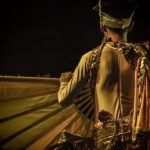Sudah lebih dari dua dekade Orde Baru tumbang, namun tak lantas membuat kesenian sepenuhnya menghirup kebebasan. Selain pers, seni menjadi salah satu cermin untuk melihat wajah penegakan HAM dan demokrasi. Represi ekspresi hingga minimnya ruang apresiasi pada kerja-kerja kebudayaan jadi tantangan dua anggota Koalisi Seni, Noviati Maulida Rahmah (Aceh) dan Haryudi Rahman (Bone). Di tengah segala keterbatasan itu, apa siasat mereka untuk memperjuangkan kebebasan berkesenian di daerahnya?
Aceh dikenal dengan syariat Islam yang mengatur kehidupan warganya. Hukuman cambuk hingga pelarangan memakai baju terbuka sering diberitakan di media massa. Syariat Islam berlaku pula pada tata cara berkesenian. Studi Pustaka Kebebasan Berkesenian 2010-2020 yang diterbitkan Koalisi Seni dengan sumber data dari SAFEnet dan YLBHI menunjukkan, 5 dari 45 kasus pelanggaran kebebasan berkesenian di Indonesia terjadi di Aceh. Mulai dari larangan pendirian bioskop, pembubaran konser, hingga larangan menari bagi perempuan dewasa. Aktor pelanggarnya tak lain adalah Pemerintah Daerah Aceh dan ormas setempat itu sendiri. Dari enam hak kebebasan berkesenian, hak ikut serta dalam kehidupan kebudayaan jadi hak yang paling banyak dilanggar di Aceh.
Menurut Novi, realitasnya tak semenakutkan berita di media massa. Seniman, utamanya perempuan, masih bisa berkesenian meski harus berkompromi dengan penafsiran syariat Islam yang berlaku di Aceh. Misal, terbatasnya waktu kegiatan seni di malam hari dan kewajiban mengenakan jilbab untuk perempuan beragama Islam atau pakaian sopan bagi penganut agama lain.
Meski demikian, ketidaksetaraan gender di Aceh menjadi satu tanda belum terpenuhinya hak ikut serta dalam kehidupan kebudayaan. Noviati ingat, kala rapat dengan pejabat setempat, kehadirannya sebagai tim ahli kesenian yang mewakili perempuan dipandang sebelah mata. Padahal, dibanding lelaki, menurutnya perempuan adalah tonggak utama dalam manajemen seni pertunjukan di Aceh.
“Saya sudah biasa masuk ke ranah manajemen dan sistem. Sebagai gender yang tidak dominan, perempuan masih sangat sedikit, terutama di Kabupaten Bireuen, dan dianggap tabu,” ujarnya.
Ketika berusaha masuk dan memengaruhi kebijakan dari dalam sistem sebagai mitra pemerintah daerah pun, Novi merasa ada anggapan laten bahwa seniman hanya bertujuan mencari uang.
“Pemerintah sering berpikir apatis kalau seniman masuk ke dalam sistem, tapi perlahan kita buktikan tidak seperti itu. Saya juga dipercaya membantu menyusun program daerah. Kesempatan ini saya gunakan untuk memasukkan peran perempuan seniman ke dalamnya,” ucap Novi yang tengah aktif mengurus Perkumpulan Nasional Teater Indonesia (Penastri) itu.
Namun, segala keterbatasan itu tak membuat Novi menghentikan tekadnya menjunjung kesempatan perempuan seniman dan kebebasan berkesenian di Serambi Makkah. Melalui kolektifnya, Rangkang Sastra jadi siasatnya menjembatani perempuan seniman yang mengatur manajemen seni di daerah.
“Awalnya berat tapi lambat laun jadi asyik. Sekarang suara mereka rasanya didengar dan nyatanya sampai hari ini bisa mengepakkan sayap,” katanya.
Senada dengan Novi, di Kabupaten Bone, Sulawesi Selatan, Haryudi Rahman menceritakan bahwa keterbatasan tak menghalangi geliat kekaryaan seniman. Dari seni musik, tari, hingga teater, tradisi hingga kontemporer begitu riuh dihelat. Komposisi gender senimannya pun beragam, tak hanya perempuan dan laki-laki, tapi ekspresi gender lokal seperti Calalay dan Calabay pun bebas berkesenian.
Namun sayangnya, semua hal itu belum didukung fasilitas seni memadai. Lapangan, kafe, dan pelataran museum terpaksa jadi “panggung” mereka. Tak satu pun gedung kesenian tersedia di Bone.
“Selain fasilitas, tata kelola belum terstruktur dengan baik. Dewan Kesenian Bone pun belum punya sistem kurasi untuk memperhatikan kesenian di sini,” tutur Haryudi.
Artinya, pemerintah daerah gagal memenuhi hak pegiat seni di Bone untuk mendapatkan dukungan, jalur distribusi, dan balas jasa atas karya. Tata kelola kurang terstruktur juga jadi salah satu penyebab kesenian Bone belum menarik perhatian. Apalagi jika dibandingkan kota lainnya di Sulawesi Selatan, seperti Makassar dengan kesenian urbannya yang mentereng dan progresif. Meski kabupaten ini telah berusia 700 tahun, Haryudi melihat tata kelola kesenian Bone seolah berjalan di tempat. Merespon kondisi ini, Haryudi dan para seniman Bone lainnya berinisiatif membentuk Aliansi Seni Budaya Bone dengan biaya dan fasilitas sendiri agar seni tetap hidup dan berkembang. Untuk memperkuatnya, mereka saling berjejaring mendukung kegiatan kesenian satu sama lain dan mengajak seniman se-Bone untuk serius berdiskusi soal UU Pemajuan Kebudayaan.
“Bone itu punya sejarah kebudayaan panjang, tapi pemerintah seolah bingung mau diapakan, tidak punya tujuan dengan potensi yang ada,” ujarnya.
Haryudi berharap pemerintah daerah dan para seniman dapat segera bersinergi mendukung UU Pemajuan Kebudayaan dan mengadvokasi terwujudnya fasilitas kesenian sebagai bentuk dukungan bagi kehidupan berkebudayaan. (Dian Putri)
Ilustrasi: needpix



